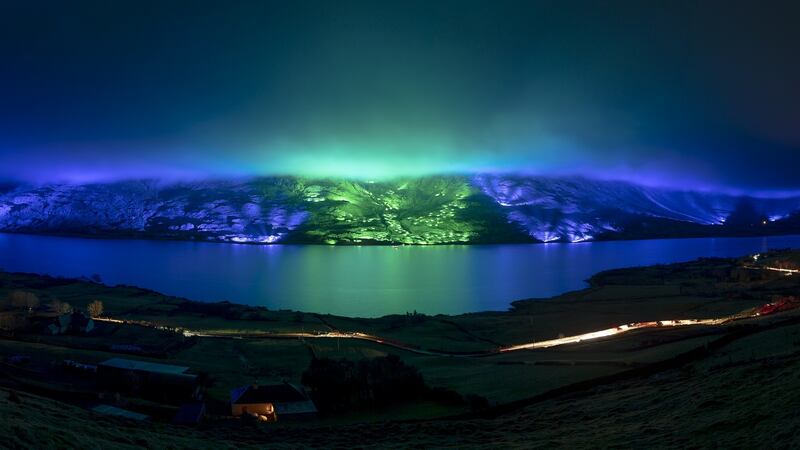Savage Beauty was one of the first Galway 2020 events to run into the coronavirus roadblock. Although, by its nature, it was due to be staged in the wilds of Connemara, it unfortunately entailed a concentration of people, an audience to the spectacle. It was a site-specific, nighttime installation on a grand scale, employing about 1,000 light sources, extending over 5km, encompassing mountainside and water. The Finnish artist responsible, Kari Kola, is a specialist in painting with light. Stonehenge numbers among his previous locations, in an extensive list. He and his team spent a fortnight, mostly in adverse weather conditions, preparing the groundwork for a beautiful lightshow.
It was not a fireworks display, it should be said. Rather, with an almost musical rhythm, the sequences of lights, woven into the grain of the land in colours sympathetic to the site, concentrated attention on the majestic scale and – perhaps appropriately – the emptiness of the setting in a way that recalled, while not resembling, the work of James Turrell. You can check this out for yourself since, denied the opportunity to gather a live audience, the organisers and the artist decided to compile a digital edition of Savage Beauty; the title draws on Oscar Wilde’s description of the Connemara landscape (see galway2020.ie).
Somehow the sensitivity and subtlety of Kola’s project makes its problematic conclusion all the more regrettable. If a big, loud, brash firework display had been planned, its suspension wouldn’t seem so bad. If Galway 2020 is a particularly stark example, its predicament is shared across the visual arts, and its recourse to an online, digital form is the most obvious solution to a widespread problem. For public spaces, the issue was clear-cut. They were closing down for the duration. Private gallerists faced a different conundrum. Without in any way facilitating gatherings of groups of people, could they continue in business? Initially at least, an openness to individual visits seemed to offer a path forward.
Disengaged narcissists
It is increasingly common for people to buy art, like everything else, online. So online presence is obviously vital. Perhaps the Covid-19 emergency, while directing attention onto the virtual world, will also indicate its limitations. It has been argued by several commentators that, rather than bringing people together, digital technologies and social media contribute to the creation of a generation of disengaged narcissists under the spell of surveillance capitalism. Other people, places and things are reduced to the status of props in a theatre of selfhood. Yet it seems a little unlikely that the person who checks out galleries online fits that profile.

For a casual browser, a virtual walk around or a guided tour is probably more welcome and appropriate
As museums and galleries have closed, the spotlight has turned to the virtual art experiences on offer. And they are considerable. Most of the main institutions in Europe and the US offer exceptionally good virtual access. And in Ireland, take the Chester Beatty Library’s remarkable riches, largely accessible online, or, likewise, the National Gallery of Ireland. Increasingly, such access allows the option that resembles an actual visit or tour. The static presentation of high-quality images together with documentary background material may better suit a researcher with a purpose. For a casual browser, a virtual walk around or a guided tour is probably more welcome and appropriate.
Online glances
Habitual gallery-goers will be familiar with the websites offering online glances through most of the work on view in temporary shows in private galleries in Dublin. The Kerlin, Kevin Kavanagh, the Molesworth, the Solomon, the Taylor and more allow detailed sampling of shows before you set foot in the galleries. Berlin Opticians took this one stage further. It is primarily a virtual gallery.
Without any intention of doing so, Dublin-born sculptor Olivia Musgrave found that her current exhibition, Metamorphosis, at the John Martin Gallery in London has gone virtual. Its opening unfortunately coincided with the escalation of Covid-19 precautions there. Martin immediately emailed everyone on the gallery’s circulation list to point this out.
But whatever about viewing two-dimensional work online, without some significant technological sleight-of-hand, sculpture presents a real challenge. Even more, perhaps, than an environmental light show in Connemara, which seems well suited to a video format. In all of these cases, one suspects that an enforced retreat to the virtual will not replace the real, and that people will, the status of Covid-19 permitting, return to the galleries with enhanced interest and a sharpened appetite.











